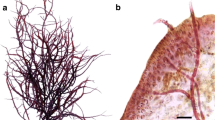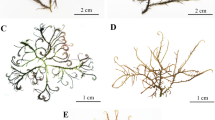Abstract
The rhodophyte marine algal genus Grateloupia (Halymeniaceae, Halymeniales) is distributed worldwide, including in offshore southeastern China. Here, we investigated morphology, carpospore development, ecological habits, and molecular analyses of a rarely studied species, Grateloupia qingdaoensis. The carpogonial branch ampullae and auxiliary cell ampullae were the typical Grateloupia type (6cpb-5auxb type) and the type of spore development was “mediate discal type”. The life history included homotypic gametophytes (haploid), carposporophytes (diploid), and tetrasporophytes (diploid) and showed a typical isomorphic alternation of generations. By using single-factor and orthogonal experiments, we explored the effects of temperature, irradiance and seawater salinity on the early development of G. qingdaoensis. Each ecological factor showed distinct effect on the early development of G. qingdaoensis. Additionally, we found a significant interactive effect between temperature and irradiance on discord crust growth. The optimum conditions for the early growth of discoid crust and upright thalli were 20 °C, 80 μmol photons m−2 s−1 irradiance and 30‰ seawater salinity. To clarify its taxonomical status, we constructed the phylogenetic tree of rbcL gene sequences. Results showed that there was no pairwise divergence between G. qingdaoensis and G. asiatica from China. Our findings indicate that previous records without precise and comprehensive comparison and molecular analyses need to be re-examined to clarify the global distribution of this species.






Similar content being viewed by others
References
Bidart-Bouzat MG (2004) Herbivory modifies the lifetime fitness response of Arabidopsis thaliana to elevated CO2. Ecology 85:297–303
Cao C, Zhao F, Guo S, Wang H (2015) Effect of temperature and light on growth of Grateloupia tenuis. Oceanol Limnol 46:298–304
Chen W, Song Z, Huang Z (2013) Effects of temperature and irradiance on early development of Grateloupia livida. South China Fish Sci 9:14–19
Choi HG, Kim YS, Kim JH, Lee SJ, Park EJ, Ryu J, Nam KW (2006) Effects of temperature and salinity on the growth of Gracilaria verrucosa and G. chorda, with the potential for mariculture in Korea. J Appl Phycol 18:269–277
Cruces E, Flores-Molina MR, Díaz MJ, Huovinen P, Gómez I (2018) Phenolics as photoprotective mechanism against combined action of UV radiation and temperature in the red alga Gracilaria chilensis? J Appl Phycol 30:1247–1257
Deng Y, Tang X, Huang B, Ding L (2011) The temperature character of marine green alga, Chaetomorpha valida, with analysis of its diffusion potential in marine algal flora of China. Oceanol Limnol 42:404–408
Elisa P, Zenilda LB, Luciane O, Débora T, Felipe B, Éder C, Carmen S (2016) Evaluation of salinity effects on the release, adhesion, and germination of the tetraspores of Gelidium floridanum (Rhodophyta, Florideophyceae). J Appl Phycol 28:2925–2938
Graham L, Wilcox L (2000) Algae. Prentice-Hall, Upper Saddle River, 640 p
Guo H, Yao J, Sun Z, Duan D (2015) Effects of salinity and nutrients on the growth and chlorophyll fluorescence of Caulerpa lentillifera. Chin J Oceanol Limnol 33:410–418
Haag JJ, Coupe MD, Cahill JF (2010) Antagonistic interactions between competition and insect herbivory on plant growth. J Ecol 92:156–167
Huber H, Kane NC, Heschel MS, von Wettberg EJ, Banta J, Leuck AM, Schmitt J (2004) Frequency and microenvironmental pattern of selection on plastic shade-avoidance traits in a natural population of Impatiens capensis. Am Nat 163:548–563
Kawaguchi S, Wang H, Horiguchi T, Sartoni G, Masuda M (2001) A comparative study of the red alga Grateloupia filicina (Halymeniaceae) from the northwestern Pacific and Mediterranean with the description of Grateloupia asiatica sp. nov. J Phycol 37:433–442
Li F, Jiang P, Zhao S, Wang H (2016) Research on the revision of Grateloupia fastigiata Li et Ding (Rhodophyta, Halymeniaceae) based on morphological observations and rbcL sequence analyses. Acta Hydrobiol Sinica 40:1249–1256
Liu F, Li W (1986) A comparative study un the mode of sporogensis of Grateloupia filicina C Ag and Grateloupia ramosissima Okam. J Fish China 10:281–287
McLachlan J (2011) The effect of salinity on growth and chlorophyll content in representative classes of marine algae. Can J Microbiol 7:399–406
Pritchard DW, Hurd CL, Beardall J, Hepburn CD (2013) Survival in low light: photosynthesis and growth of a red alga in relation to measured in situ irradiance. J Phycol 49:867–879
ProProvasoli L, Watanabe H, Hattori A (1968) Media and prospects for the cultivation of marine algae. In: Watanabe A, Hattori A (eds) Culture and collection of algae US–Japan conference. Japanese Society of Plant Physiology, Hakone, pp 63–75
Ryuta T, Shingo I, Gregory NN (2013) The effect of light and temperature on the growth and photosynthesis of Gracilariopsis chorda (Gracilariales, Rhodophtya) from geographically separated locations of Japan. J Appl Phycol 25:1863–1872
Tamura K, Peterson D, Peterson N, Stecher G, Nei M, Kumar S (2011) Mega5: molecular evolutionary genetics analysis using maximum likelihood, evolutionary distance, and maximum parsimony methods. Mol Biol Evol 28:2731–2739
Team (2012) R: a language and environment for statistical computing. Computing 1:12–21
Tian Y, Liu Y, Wang H (2017) Early development and life cycle of Grateloupia lanceolata. Oceanol Limnol 48:113–121
Wang H, Kawaguchi S, Horiguchi T, Masuda M (2000) Reinstatement of Grateloupia catenata (Rhodophyta, Halymeniaceae) on the basis of morphology and rbcL sequences. Phycologia 39:228–237
Wei Z, Zhu M, Yu G (2012) Occurrence of planktonic cyanobacterium Tychonema bouurrellyi in Erhai Lake and its taxonomic studies. Acta Hydrobiol Sinica 36:1171–1175
Xia B, Wang Y, Xia E, Li W, Ding Z (2004) Grateloupia C. Agardh. In: Xia B (ed) Flora Algarum Marinarum Sinicarum (Tomus II Rhodophyta, No.3 Gelidiales, Cryptonemiales, Hildenbrandiales). Science Press, Beijing, pp 127–130
Yu CH, Lim PE, Phang SM (2013) Effects of irradiance and salinity on the growth of carpospore-derived tetrasporophytes of Gracilaria edulis and Gracilaria tenuistipitata var liui (Rhodophyta). J Appl Phycol 25:787–794
Zhang X (2013) A study on the early development and temperature and light intensity on the five species, (Gigartinales, Rhodophyta) from China. Liaoning Normal University, Dissertation
Zou M, Zhang S, Zhou XJ (2017) The influence of temperature and light intensity on Sargassum vachellianum detritus decomposition. Chin J Ecol 36:428–435
Funding
This study was financially supported by the National Natural Science Foundation of China (No. 31570209).
Author information
Authors and Affiliations
Corresponding author
Ethics declarations
Conflict of Interest
The authors have declared that they have no conflict of interest.
Additional information
Publisher’s note
Springer Nature remains neutral with regard to jurisdictional claims in published maps and institutional affiliations.
Electronic supplementary material
ESM 1
(DOCX 28.9 kb)
Rights and permissions
About this article
Cite this article
Liu, J., Li, J., Bian, Y. et al. The morphological, developmental and molecular landscape of Grateloupia qingdaoensis Li et Ding. J Appl Phycol 32, 2093–2103 (2020). https://doi.org/10.1007/s10811-020-02046-y
Received:
Revised:
Accepted:
Published:
Issue Date:
DOI: https://doi.org/10.1007/s10811-020-02046-y




